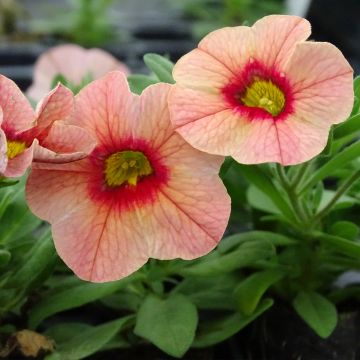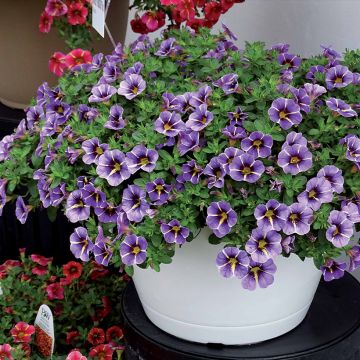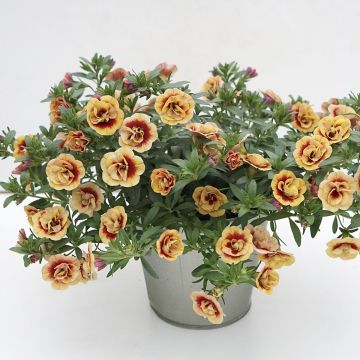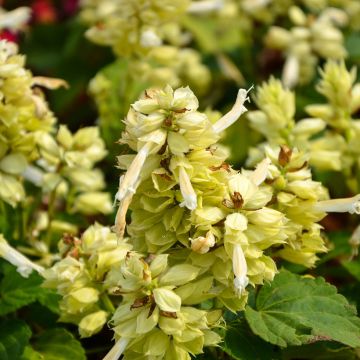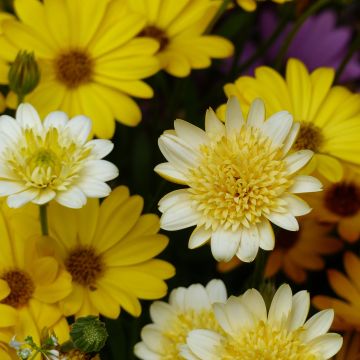

5 double Calibrachoa or Mini-petunias collection
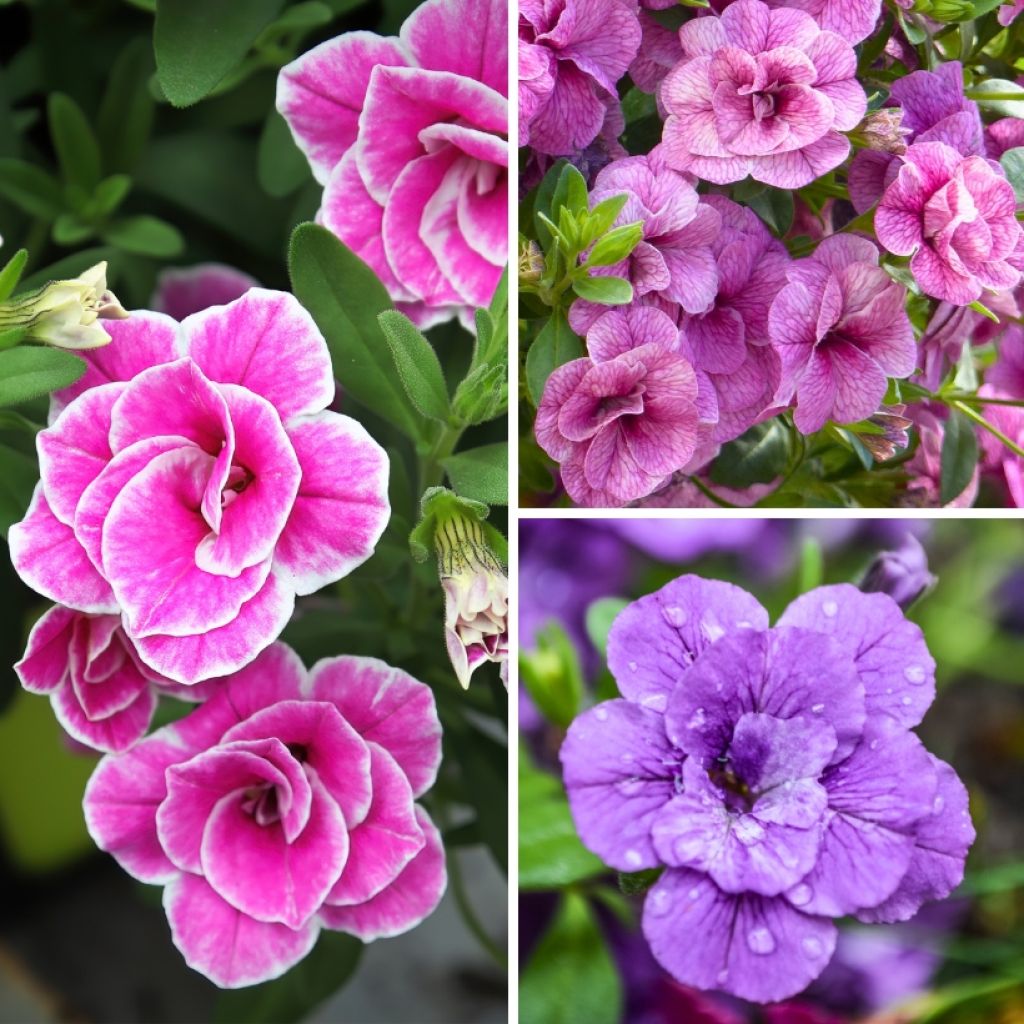

5 double Calibrachoa or Mini-petunias collection
5 double Calibrachoa or Mini-petunias collection
Calibrachoa (x) hybrida Can-Can Rosies Blue, Can-Can Rosies Pink Vein, Superbells Sweet Love,
Million bells
The mini petunias did not develop well except for the blue one. The other roses just vegetated until they disappeared. Quite disappointed.
Marie-beatrix , 23/09/2024
This item cannot be shipped to the selected country
Delivery charge from €5.90
More information
Schedule delivery date,
and select date in basket
This plant carries a 6 months recovery warranty
More information
We guarantee the quality of our plants for a full growing cycle, and will replace at our expense any plant that fails to recover under normal climatic and planting conditions.
From €5.90 for pickup delivery and €6.90 for home delivery
Express home delivery from €8.90.

Does this plant fit my garden?
Set up your Plantfit profile →
Collection items (5 plants)
-
Calibrachoa Can-Can Rosies Pink Vein - Double Mini Petunia
Price per single item: €2.10Find out more
Description
We offer you this lovely collection of 5 Calibrachoa or Mini Petunias with double flowers, in violet, orange, pink, and red, to liven up your balconies and terraces until the first frost. It includes 3 recent varieties from the 'Cancan' series, 'Rosies Blue', with an intense blue-violet color, 'Rosies Pink Vein' and 'Rosies Magenta' a MiniFamous Double Pinktastic petunia, all three in different shades of pink, as well as an excellent variety with ruby red flowers from the Superbells series. These plants require little water and light, have a compact habit and a neat appearance, and require minimal maintenance. This collection is sold as a set of 5 plug plants, one of each variety.
Calibrachoa, sometimes called Million Bells, are tender perennial plants often grown as annuals. Very similar to petunias, their flowers are smaller, their growth habit is shrubby or herbaceous with woody stems, and they have a smaller size and better drought tolerance. The hybrids that make up this group all belong to the Solanaceae family (like tomatoes) and are probably descended from an Argentine species called Petunia integrifolia.
The variety 'Can-Can Rosies Blue' offers small 100% double flowers, funnel-shaped, in a very beautiful intense blue-violet shade, and quickly forms a mound that is initially taller than wide, measuring 40 to 50 cm (16 to 20in) in height and 30 to 40 cm (12 to 16in) in diameter, then spreads out via its flexible and ramified stems. 'Can-Can Rosies Pink Vein', with the same stature and habit, bears small double flowers, delicately veined with dark pink on a background of soft pink, in the shape of flared trumpets composed of a small corolla of crumpled petals arranged in the center of a fused corolla. The Calibrachoa 'Neo Double Orange Tastic' produces countless small double flowers in a mix of orange, yellow, coppery red, and bronze, giving the plant a truly unique charm. 'Superbells Sweet Love' forms a pretty, dense, and slightly trailing dome, and produces an abundance of small double flowers with pink petals edged in white for a very long period. The double trumpet-shaped flowers of 'Superbells Double Ruby' resemble small roses in an intense and velvety red, on a plant that measures between 40 and 60 cm (16 and 24in) in height.
In these Calibrachoas, the flexible and ramified stems are densely covered with small, lanceolate, evergreen, velvety, and slightly sticky leaves of medium green color. The tireless flowering occurs from June until the first frost. Numerous small double trumpet-shaped flowers are born in the axils of the leaves; they are on average 3 to 4 cm (1 to 2in) wide. Unlike petunias, these calibrachoas do not need to be pruned during the season, which makes them extremely rewarding annual plants that are easy to grow and suitable for all gardeners, even beginners.
This delightful collection of Calibrachoa allows you to easily create a beautiful summer decor for your terrace or balcony. All five are perfect in hanging baskets, containers, or pots, but their drought tolerance and the excellent colour retention in shade also allow them to be used in the ground, where they form very pretty borders in flower beds. They can be planted alone or in a mix of 2 or 3 complementary varieties, in troughs, flower pots, or balcony boxes on the terrace, balcony, or patio. They are also good plants for a conservatory. Their association with Verbenas, Surfinia Petunias, and Nemesias is remarkable. The choice is vast and allows for imagination and the tastes of each gardener, even inexperienced ones.
Note: Attention, our young plug plants are professional products reserved for experienced gardeners: upon receipt, repot and store them under cover (conservatory, greenhouse, cold frame) at a temperature above 14C° for a few weeks before planting them outdoors once the risk of frost is definately gone.
Report an error about the product description
Flowering
Foliage
Plant habit
Botanical data
Calibrachoa
(x) hybrida
Can-Can Rosies Blue, Can-Can Rosies Pink Vein, Superbells Sweet Love,
Solanaceae
Million bells
Cultivar or hybrid
Other Calibrachoa or Mini-petunia
Planting and care
You can plant your Calibrachoas in the ground or in a pot. If you want to plant them in the ground, in soil enriched with compost, wait until the last heavy frosts have passed. In the meantime, you can pre-cultivate them in a pot in a warm and bright place to accelerate their growth. The Calibrachoas will flower from June to September-October. Plant them in a sunny or semi-shaded location, sheltered from the wind. They need a light and humus-bearing but above all well-drained soil, and they are sensitive to stagnant water. Do not water them too much at the beginning of their growth as they are sensitive to excess moisture. They tolerate drought well, but will need regular watering during hot summer periods. Very floriferous and fast-growing, they are hungry plants, we recommend feeding them with a liquid fertilizer for surfinias once or twice a week during the growth period. Although not obligatory, you can remove faded flowers and dry leaves as they appear to keep them looking good and extend the flowering period.
Planting period
Intended location
Care
-
, onOrder confirmed
Reply from on Promesse de fleurs
Plug plants - Annuals
Haven't found what you were looking for?
Hardiness is the lowest winter temperature a plant can endure without suffering serious damage or even dying. However, hardiness is affected by location (a sheltered area, such as a patio), protection (winter cover) and soil type (hardiness is improved by well-drained soil).

Photo Sharing Terms & Conditions
In order to encourage gardeners to interact and share their experiences, Promesse de fleurs offers various media enabling content to be uploaded onto its Site - in particular via the ‘Photo sharing’ module.
The User agrees to refrain from:
- Posting any content that is illegal, prejudicial, insulting, racist, inciteful to hatred, revisionist, contrary to public decency, that infringes on privacy or on the privacy rights of third parties, in particular the publicity rights of persons and goods, intellectual property rights, or the right to privacy.
- Submitting content on behalf of a third party;
- Impersonate the identity of a third party and/or publish any personal information about a third party;
In general, the User undertakes to refrain from any unethical behaviour.
All Content (in particular text, comments, files, images, photos, videos, creative works, etc.), which may be subject to property or intellectual property rights, image or other private rights, shall remain the property of the User, subject to the limited rights granted by the terms of the licence granted by Promesse de fleurs as stated below. Users are at liberty to publish or not to publish such Content on the Site, notably via the ‘Photo Sharing’ facility, and accept that this Content shall be made public and freely accessible, notably on the Internet.
Users further acknowledge, undertake to have ,and guarantee that they hold all necessary rights and permissions to publish such material on the Site, in particular with regard to the legislation in force pertaining to any privacy, property, intellectual property, image, or contractual rights, or rights of any other nature. By publishing such Content on the Site, Users acknowledge accepting full liability as publishers of the Content within the meaning of the law, and grant Promesse de fleurs, free of charge, an inclusive, worldwide licence for the said Content for the entire duration of its publication, including all reproduction, representation, up/downloading, displaying, performing, transmission, and storage rights.
Users also grant permission for their name to be linked to the Content and accept that this link may not always be made available.
By engaging in posting material, Users consent to their Content becoming automatically accessible on the Internet, in particular on other sites and/or blogs and/or web pages of the Promesse de fleurs site, including in particular social pages and the Promesse de fleurs catalogue.
Users may secure the removal of entrusted content free of charge by issuing a simple request via our contact form.
The flowering period indicated on our website applies to countries and regions located in USDA zone 8 (France, the United Kingdom, Ireland, the Netherlands, etc.)
It will vary according to where you live:
- In zones 9 to 10 (Italy, Spain, Greece, etc.), flowering will occur about 2 to 4 weeks earlier.
- In zones 6 to 7 (Germany, Poland, Slovenia, and lower mountainous regions), flowering will be delayed by 2 to 3 weeks.
- In zone 5 (Central Europe, Scandinavia), blooming will be delayed by 3 to 5 weeks.
In temperate climates, pruning of spring-flowering shrubs (forsythia, spireas, etc.) should be done just after flowering.
Pruning of summer-flowering shrubs (Indian Lilac, Perovskia, etc.) can be done in winter or spring.
In cold regions as well as with frost-sensitive plants, avoid pruning too early when severe frosts may still occur.
The planting period indicated on our website applies to countries and regions located in USDA zone 8 (France, United Kingdom, Ireland, Netherlands).
It will vary according to where you live:
- In Mediterranean zones (Marseille, Madrid, Milan, etc.), autumn and winter are the best planting periods.
- In continental zones (Strasbourg, Munich, Vienna, etc.), delay planting by 2 to 3 weeks in spring and bring it forward by 2 to 4 weeks in autumn.
- In mountainous regions (the Alps, Pyrenees, Carpathians, etc.), it is best to plant in late spring (May-June) or late summer (August-September).
The harvesting period indicated on our website applies to countries and regions in USDA zone 8 (France, England, Ireland, the Netherlands).
In colder areas (Scandinavia, Poland, Austria...) fruit and vegetable harvests are likely to be delayed by 3-4 weeks.
In warmer areas (Italy, Spain, Greece, etc.), harvesting will probably take place earlier, depending on weather conditions.
The sowing periods indicated on our website apply to countries and regions within USDA Zone 8 (France, UK, Ireland, Netherlands).
In colder areas (Scandinavia, Poland, Austria...), delay any outdoor sowing by 3-4 weeks, or sow under glass.
In warmer climes (Italy, Spain, Greece, etc.), bring outdoor sowing forward by a few weeks.








































